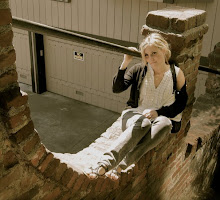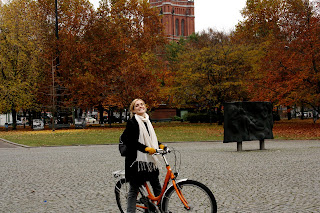
The list of cities that once looked so long, the painstaking research and follow-up hotel emails, and the 14 page single-spaced itinerary that had taken all summer to work on, had all come down to one last city, one last itinerary paragraph. Jason and I were in Dresden.
After we arrived and checked into our hostel, we walked down to Dresden’s Neumarkt area and found a lovely place to have baked brie and goat cheese on toast with garlic, red onion, and balsamic (sooo good!). We then walked the streets of the “old” city. Recently rebuilt to look exactly as it had before 1945, Dresden’s cobblestone old town district is technically new. The buildings all lit up at night were magnificent, and both of us were excited about touring these churches, palaces, and museums the next day.
Thursday was our last full day in Germany and the whole city sparkled with sunlight. Except for the occasional dotted cloud, the expansive sky was completely blue. I believed it was a sign that we should stay longer, since this type of weather was novel to us rain-beaten travelers. If only we could have… Ok ok, enough of this musing nonsense and on to the day:
We walked first to the Elbe River and strolled along the Bruehlsche Terrasse, an attractive stone terrace that once used to be part of the city’s fortifications. It forms a thick stone wall coming up from the river and canon holes are plainly visible on the side. Yet because its military importance is no longer needed, this “balcony of Europe” (named because of its magnificent views of the river below) was transformed into beautiful gardens by Heinrich von Bruehl. This famous terrace leads right to Dresden’s Hofkirche—a monumental Baroque royal church, built for the city’s Catholics in a strictly Protestant section of Saxony—where Jason and I toured the gorgeous interior before continuing our sunny morning stroll to the Saechsische Staatsoper—the neo-Renaissance building of the Saxon state opera. Although under construction, the telling beauty of why this building is one of Dresden’s famous landmarks remained quite obvious.
Next on the agenda, a 10:45am appointment to keep (made several months in advance) at the Historisches Grünes Gewölbe—Dresden’s historic Green Vault, and the most famous and extensive treasury in Europe. I am not sure if Jason and I were both prepared for what was to come; well, at least I wasn’t. When our appointment time arrived, we had to leave everything at the cloakroom—no cameras, no wallets, no cell phones, nothing. A little line formed in front of these double glass doors and two people at a time were allowed to enter. They stayed between the two glass doors for about 30 seconds while the bottoms of their shoes were brushed with this automated mat, and only then were they finally allowed to enter the first room of the vault.
When we finally crossed this threshold, our eyes feasted on an array of delicately-crafted amber objects, gold and glittering stones, ivory gilded chalices, ornate diamond-studded necklaces, various ornaments and table decorations, golden shields, and bronze statues. To think that somehow, most of these one-of-a-kind treasures made it though the fire-bombing when so much was destroyed, was truly phenomenal.
After our bout with royal jewels was complete, it was time for lunch. Not truly hungry or wanting to pay the steep prices asked by the cute restaurant we chose, I slowly ate my soup and watched Jason make the best of his gelatin-mold covered conglomeration of minced pork meat, vegetables, and other unknown substances. And finally, on our last day, Jason discovered a German food not to his liking :-).
After a slight time delay, we were able to enter the newly renovated Frauenkirche (only completed in 2006). The rubble of this giant church after the war was left by the Communists to serve simply as a memorial and a reminder of the evils of war and Nazism. Only in 1993, were builders able to start reconstruction, and artistically incorporate the original blackened stones into the church’s beige facade. The spectacular interior of white marble and pastel colors floating up and intertwining with all three levels of the church was truly divine. This carefully crafted interior was our favorite of the entire trip, yet to be fair to the 30 plus other church interiors we visited, this one was the newest—made to look old with modern technology, and at an unfair advantage to the ones all made by hand in the 13th century.
After a delicious Kaffeeklatch (or in my case, hot chocolate) at a richly decorated nearby hotel/restaurant, we returned to the hostel; Jason, so he could take a nap, and myself, so I could walk around the block to Dresden’s Hygiene Museum. I was a little wary about visiting this museum, but was recommended to go here by Jens Daehner, a curator of antiquities at the Getty Museum and who is from Dresden. This place was surreal, quite thought-provoking, and at times a little nauseating since its focus was on the human body and each of its systems (in graphic detail) in order to discuss social implications in Germany and around the world. Maybe it was beneficial that I couldn’t understand the placards so as not to know what it was that I was looking at :-). Either way, despite being slightly unnerved the whole time, I was glad I went. (However, I did still have to get through dinner with Jason without thinking about the video I watched of food particles passing through the intestinal tract.)
Our last evening out was made enjoyable by Italian food and espressos, a walk around town, and a slight mist that made the street lamps glisten. It was so weird to think that in such short time, we would be walking the streets of downtown Santa Barbara, although a much-missed burrito in hand would be more likely ;-). We returned early to pack and get ready for our early morning checkout. Our 11am flight out of Dresden’s new airport was quickly approaching, and the only thing that separated us from a long day of travel chaos, was seven hours of sleep in our last European beds.














